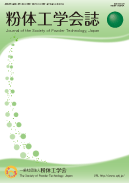
- |<
- <
- 1
- >
- >|
-
 Yoshitaka Kataoka, Kozo YokotaArticle type: Original Paper
Yoshitaka Kataoka, Kozo YokotaArticle type: Original Paper
2020Volume 57Issue 10 Pages 520-525
Published: October 10, 2020
Released on J-STAGE: December 09, 2020
JOURNAL FREE ACCESSMaterial extrusion is an additive manufacturing process that generates a three-dimensional molded product via extrusion and lamination of a plastic material. In this study, we prepared zirconia filaments, which were composites of 3Y-ZrO2 powder and thermoplastic resins. Then, we investigated the influence of the filament fluidity and molding conditions on the voids generated at the bonded interface due to poor bonding of the extruded materials. Using a filament excelling in fluidity reduced the nozzle temperature, and molding could be carried out with reduced combustion of the binder resin. Hence, the void diameters of the molded bodies were reduced to 10 μm or lesser with the nozzle temperature of 138°C and layer thickness of 100 μm, and 97–98% relative densities of the sintered bodies were indicated.
View full abstractDownload PDF (1873K)
-
Yasuo Kousaka, Toshiyuki Nomura, Makio NaitoArticle type: Short Communication
2020Volume 57Issue 10 Pages 526-529
Published: October 10, 2020
Released on J-STAGE: December 09, 2020
JOURNAL FREE ACCESSAerosol infection issues by COVID-19 were discussed from the viewpoint of particle technology, and the following conclusions were obtained: 1) Number of virus contained in a 10 μm droplet is very few, only 1 virus per 2000 droplets, whereas 0.5 virus in a 100 μm droplet, if 106 copies/mL of viral load in saliva is assumed. 2) Droplets larger than 100 μm can quickly settle down by gravity. 3) The possibility of aerosol infection is very low unless in unusual environments. 4) Mask is very effective, but the leakage from the space between mask and face has risk in heavy exhalation.
View full abstractDownload PDF (378K)
-
Shin-ichiro KimuraArticle type: Review: Frontier Research Series
2020Volume 57Issue 10 Pages 530-535
Published: October 10, 2020
Released on J-STAGE: December 09, 2020
JOURNAL RESTRICTED ACCESSIn pharmaceutical field, technology for manufacturing fine globular granules with a narrow size of particle distribution (100–200 μm) are crucially important in enhancing patient adherence and controlling drug release from functional granules, e.g., sustained release or taste-masking granules. A unique multi-functional rotor processor, “Granurex®” (GX, Freund, Japan), facilitate manufacturing the fine globular granules. In this study, we examined the relationships between operational conditions of the multi-functional rotor processor and the physical characteristics of the obtained granules, and optimized the manufacturing conditions for producing fine globular granules. In addition, we developed highly drug-loaded fine globular granules which composed of almost drug substance (>97%). We believe fundamental information obtained in this study will be important for the development of processes for the facile manufacture of fine globular granules of various drugs.
View full abstractDownload PDF (1459K)
-
Kuniaki Gotoh, Motoyuki IijimaArticle type: Fundamentals of Powder Technology, 2nd Edition
2020Volume 57Issue 10 Pages 536-541
Published: October 10, 2020
Released on J-STAGE: December 09, 2020
JOURNAL RESTRICTED ACCESSDownload PDF (1013K)
- |<
- <
- 1
- >
- >|